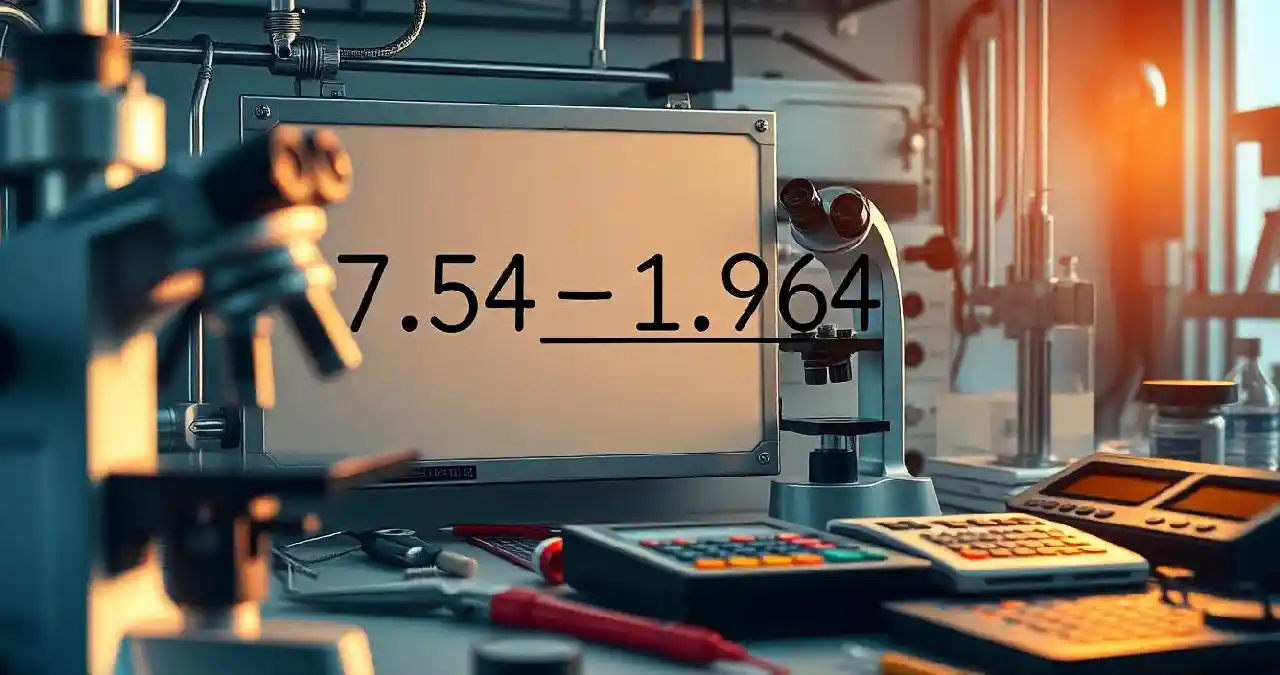In the realm of mathematical precision, the result of 7.54 minus 1.964 isn’t merely a number but a gateway to understanding numerical accuracy. It’s fascinating how such operations form the building blocks of complex equations. For experts, these calculations are the essence of numerous theories and practical applications.
Subtracting 1.964 from 7.54 yields a precise difference of 5.576, a figure often overlooked but critical in various scientific and economic models. Historically, such quantifications have advanced technological development, driving innovations through precise measurements. Understanding this seemingly simple subtraction showcases the subtle complexities present in quantitative analysis.
Relevance of Precision in Mathematical Calculations: A Case of 7.54-1.964
Precision in math, like the calculation of 7.54 minus 1.964, shows how little things make a big difference. Even slight variations can change outcomes. This idea is important in fields from science to construction. Precise calculations lead to accurate results. They help in creating reliable solutions.
At school, you may have encountered tricky math problems. With numbers like 7.54 and 1.964, each decimal has meaning. This exercise highlights the role of careful subtraction. It underscores the value of practice and focus. It also boosts problem-solving skills.
Consider technology and its impact on our lives. Even small errors in device measurements matter. A wrong decimal could lead to faulty engineering. Therefore, attention to detail secures successful projects. This adds more significance to precision in math.
Our everyday activities also rely on precise calculations. When you bake or follow a recipe, those measurements must be exact. Incorrect ingredient amounts can spoil your dish. Similarly, precise math offers the right solutions. For many, it prevents mistakes and ensures success.
The Impact of Subtraction in Quantitative Analysis
Subtraction plays a vital role in quantitative analysis by simplifying data and highlighting differences. This basic mathematical operation helps in understanding changes over time, such as comparing last year’s sales to this year’s figures. It reveals trends that guide business decisions. In science, subtraction aids in isolating variables to see specific effects. These varied uses show how subtraction informs critical analyses across fields.
Quantitative analysis often involves large sets of data. Subtraction helps by making this data manageable. It breaks down complex numbers into simpler forms. This process ensures accuracy in results. Accurate calculations are essential for predictions and future planning.
Consider a simple example of analyzing two data sets. Subtracting one value from another uncovers differences that may not be obvious at first glance. These differences can identify errors or unusual patterns. Recognizing these variations is crucial for valid analysis. In finance, this can prevent large-scale losses.
In many professions, a little subtraction is a big help. Take architects, who subtract to calculate materials needed for construction. This ensures efficient use of resources. Similarly, engineers subtract when checking measurements and weights. This careful method supports safe and solid structures.
How 7.54-1.964 Influences Scientific and Economic Models
The calculation of 7.54 minus 1.964 goes beyond basic math. It illustrates how even small numbers impact scientific models. Precision is key in science, where such differences can affect entire experiments. Scientists rely on accurate subtraction to measure outcomes. These calculations ensure the validity of their findings.
In the economic world, numbers’ precision guides decisions. Subtracting 1.964 from 7.54 might reflect changes in market prices or economic growth rates. Analysts use these calculations to build models predicting trends. Accurate subtraction helps businesses plan for the future. This precision prevents financial loss.
Let’s break it down into practical applications. In physics, calculating forces involves subtracting measurements. This helps scientists understand the motion of objects. Accuracy in math impacts their predictions. Even tiny errors can lead to vastly different results.
In economics, precise subtraction aids in budgeting and forecasting. Consider a company analyzing profits over time. Subtracting expenses from revenue reveals financial health. These deductions help businesses set goals and invest wisely. Precise math is a pillar for successful planning.
Role of 7.54-1.964 in Technological Development
Numbers like 7.54 minus 1.964 may seem trivial at first glance, but they have significant roles in technology. Engineers and scientists use such precise calculations in designing everything from bridges to algorithms. Precision ensures tools and devices work safely and efficiently. Without accurate subtraction, designs could fail. It’s crucial for advancement and safety.
Consider the technology that powers your smartphone. Its microprocessors operate using calculations like these. Small numerical differences can make devices faster and more efficient. This enhances user experience, as everything runs smoothly. Precision in number operations ensures your gadgets function effectively.
Even in the realm of coding, subtraction plays a vital part. Programmers rely on precise data to create software applications. Calculations influence how a software performs operations and solves problems. A single mistake in these numbers can lead to significant errors. Exact computations support robust and reliable software.
Beyond gadgets and software, precision also affects advanced fields like robotics. Robots depend on precise calculations to move accurately. Subtraction helps determine the force and direction needed. These calculations ensure that robots perform tasks effectively in industries. Precision enables them to automate complex tasks.
Advanced technology like artificial intelligence and machine learning also capitalizes on precise math. Algorithms use exact numbers to analyze data and make predictions. Accurate subtraction supports these systems in providing insightful results. For developers, precision leads to groundbreaking innovations. This accuracy drives progress in emerging technologies.
The Underlying Complexities of Simple Mathematical Operations
On the surface, simple mathematical operations like addition and subtraction seem straightforward. However, there’s more beneath the surface. These operations form the foundation of complex equations. They are critical in fields from engineering to finance. Understanding them thoroughly is essential for success in these areas.
Consider subtraction’s role in everyday situations. It’s not just about taking one number from another. Subtraction reveals change, compares values, and shows differences. For instance, tracking expenses involves repeated subtractions. This shows its importance in financial planning.
Operations like subtraction carry more weight in scientific research. Precise subtractions help determine variations in experiments. Errors in these basic calculations can skew entire studies. Scientists trust in accuracy to validate their theories. Therefore, mastering these basics is crucial for scientific integrity.
Even in technology, simple math acts as a core building block. Coding languages depend on using math to perform complex tasks. These operations guide software behavior and performance. A simple mistake can lead to bugs or crashes. Thus, accuracy ensures reliability in digital tools.
The educational sector emphasizes these operations for a reason. Tasks as basic as finding averages need subtraction and addition. Schools teach these to prepare students for future roles. Whether in business or science, these skills are vital. It’s the mastery of these basics that drives progress.
Conclusion
The exploration of the simple subtraction 7.54-1.964 underscores the integral role of precise calculations in diverse fields. In your domain, an accurate approach to numbers ensures reliability across models and predictions. These seemingly small calculations provide the foundation for complex systems and analyses.
As you navigate the realms of science, economics, or technology, the importance of precision cannot be overstated. Your ability to harness these basic mathematical operations effectively supports innovation and informed decision-making. Precision in these operations equips you to drive progress in any technical endeavor.


Sarah Jay